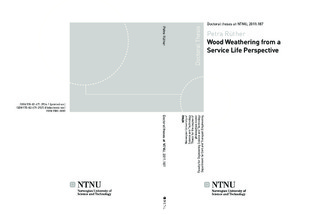| dc.contributor.author | Rüther, Petra | nb_NO |
| dc.date.accessioned | 2014-12-19T11:28:13Z | |
| dc.date.available | 2014-12-19T11:28:13Z | |
| dc.date.created | 2011-11-15 | nb_NO |
| dc.date.issued | 2011 | nb_NO |
| dc.identifier | 470933 | nb_NO |
| dc.identifier.isbn | 978-82-471-2924-1 (printed ver.) | nb_NO |
| dc.identifier.isbn | 978-82-471-2925-8 (electronic ver.) | nb_NO |
| dc.identifier.uri | http://hdl.handle.net/11250/231991 | |
| dc.description.abstract | Untreated wooden cladding has a long tradition and has in recent years become a both economically and environmentally beneficial solution in miscellaneous modern building applications. Untreated wood in cladding and similar applications represents a building part that changes its appearance rather dramatically without compromising its technical functionality. The aesthetic service life is often the decisive criterion for these applications. This thesis comprises a study on the weathering of untreated, i.e. unpainted wood. Following the service life prediction methodology suggested in the ISO 15686 standard, wood was weathered both outdoors and in two laboratory weathering apparatuses. Climate data for the test site were assessed including temperature, wind-driven rain and solar radiation. The performance of non-structural wood components in exterior above-ground applications is often closely related to the aesthetics of the wooden component in question. Hence, a method for color determination of large samples was developed, and the topic of human color perception is discussed briefly. It was found that the colonization by mold growth fungi contributes significantly to its surface appearance. Differences between materials and exposure directions were investigated. The topic of limit-state for aesthetic service life is discussed and a possible assessment method for such applications is presented. No simple dose-response relationship between solar radiation and wind-driven rain, and color response of the material could be established. Acceleration factors for the conducted laboratory weathering tests are discussed. Furthermore, color changes by outdoor versus laboratory weathering were evaluated. It was found that the conducted laboratory weathering cycles could not recreate the visual appearance of an outdoor weathered surface. In summary, the suggested bottom-up approach of the service life prediction methodology is not easily adaptive for wood in this application | nb_NO |
| dc.language | eng | nb_NO |
| dc.publisher | Norges teknisk-naturvitenskapelige universitet, Fakultet for ingeniørvitenskap og teknologi, Institutt for bygg, anlegg og transport | nb_NO |
| dc.relation.ispartofseries | Doktoravhandlinger ved NTNU, 1503-8181; 2011:187 | nb_NO |
| dc.relation.haspart | Lauter, P.; Time, B.; Hovde, P.J.; Nore, K.. Influence of material quality and climate exposure on moisture condition of a wooden facade. presented at the 9 th International Conference on the Durability of Building Materials and Components, Lyon, France, 2005, 2005. | nb_NO |
| dc.relation.haspart | Lauter, P.; Time, B.. A method to assess the effects of climate and material parameters on the moisture condition of a wooden facade. 7th Symposium on Building Physics in the Nordic Countries, 2005. | nb_NO |
| dc.relation.haspart | Rüther, P.. Color changes in wood boards during weathering. Proceedngs of the 9th World Conference on Timber Engineering, 2006. | nb_NO |
| dc.relation.haspart | Rüther, P; Jelle, B.P.. Color changes of wood and wood based materials due to natural and artificial weathering. . | nb_NO |
| dc.title | Wood Weathering from a Service Life Perspective | nb_NO |
| dc.type | Doctoral thesis | nb_NO |
| dc.contributor.department | Norges teknisk-naturvitenskapelige universitet, Fakultet for ingeniørvitenskap og teknologi, Institutt for bygg, anlegg og transport | nb_NO |
| dc.description.degree | PhD i bygg, anlegg og transport | nb_NO |
| dc.description.degree | PhD in Civil and Transport Engineering | en_GB |
